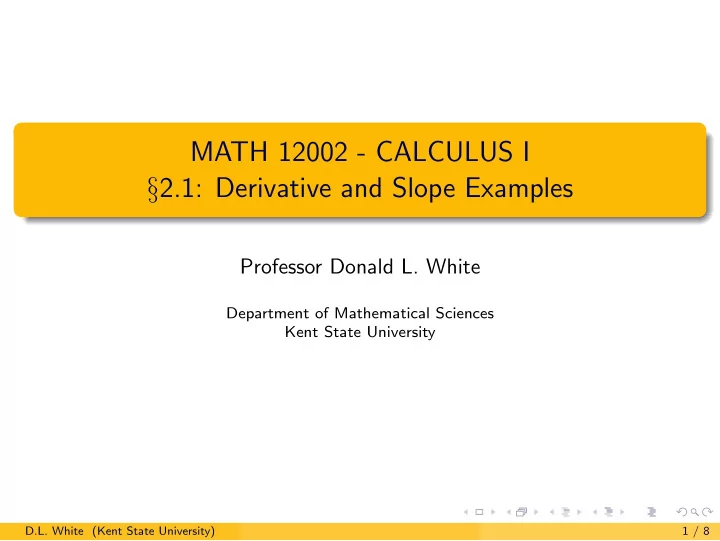

MATH 12002 - CALCULUS I § 2.1: Derivative and Slope Examples Professor Donald L. White Department of Mathematical Sciences Kent State University D.L. White (Kent State University) 1 / 8
Examples Example Find the equation of the tangent line to f ( x ) = 1 x at x = 4 . Solution We need to determine the slope of the line and a point on the line. Since the line is tangent to the graph of f at x = 4 , the line and the graph 4 , 1 � � both pass through the point (4 , f (4)) = . 4 The slope of the line is f (4 + h ) − f (4) f ′ (4) = lim . h h → 0 [Continued → ] D.L. White (Kent State University) 2 / 8
Examples Solution [continued] Calculate the slope: 4+ h − 1 1 f (4 + h ) − f (4) 4 f ′ (4) = lim = lim h h h → 0 h → 0 � � 4 − (4+ h ) 4 4+ h 4(4+ h ) − 4(4+ h ) (4+ h )4 = lim = lim h h h → 0 h → 0 4 − 4 − h − h = lim 4(4 + h ) · h = lim 4(4 + h ) · h h → 0 h → 0 − 1 = lim 4(4 + h ) , since h � = 0 , h → 0 4(4 + 0) = − 1 − 1 = 16 . [Continued → ] D.L. White (Kent State University) 3 / 8
Examples Solution [continued] Hence the tangent line has slope − 1 16 and passes through the point (4 , 1 4 ) . By the Point-Slope form of the equation of a line, the equation of the tangent line is y − 1 4 = − 1 16( x − 4) , and simplifying yields y = − 1 16 x + 4 16 + 1 4 , or y = − 1 16 x + 1 2 . D.L. White (Kent State University) 4 / 8
Examples Example Let f ( x ) = x 2 − 5 x. Find f ′ (2) , f ′ (3) , and f ′ (4) . Solution Let’s first compute f ′ (2) : f (2 + h ) − f (2) f ′ (2) = lim h h → 0 [(2 + h ) 2 − 5(2 + h )] − [2 2 − 5(2)] = lim h h → 0 [4 + 4 h + h 2 − 5(2) − 5 h ] − [4 − 10] = lim h h → 0 4 + 4 h + h 2 − 10 − 5 h − 4 + 10 = lim h h → 0 [Continued → ] D.L. White (Kent State University) 5 / 8
Examples Solution [continued] 4 + 4 h + h 2 − 10 − 5 h − 4 + 10 = lim h h → 0 − h + h 2 = lim h h → 0 h ( − 1 + h ) = lim h h → 0 = h → 0 ( − 1 + h ) , since h � = 0 , lim = − 1 + 0 = − 1 . Hence f ′ (2) = − 1 . We could find f ′ (3) and f ′ (4) using the same method, but it will be more efficient to find f ′ ( a ) for any number a first. [Continued → ] D.L. White (Kent State University) 6 / 8
Examples Solution [continued] f ( a + h ) − f ( a ) f ′ ( a ) = lim h h → 0 [( a + h ) 2 − 5( a + h )] − [ a 2 − 5 a ] = lim h h → 0 [ a 2 + 2 ah + h 2 − 5 a − 5 h ] − [ a 2 − 5 a ] = lim h h → 0 a 2 + 2 ah + h 2 − 5 a − 5 h − a 2 + 5 a = lim h h → 0 2 ah + h 2 − 5 h = lim h h → 0 [Continued → ] D.L. White (Kent State University) 7 / 8
Examples Solution [continued] 2 ah + h 2 − 5 h = lim h h → 0 h (2 a + h − 5) = lim h h → 0 = h → 0 (2 a + h − 5) , since h � = 0 , lim = 2 a + 0 − 5 = 2 a − 5 . Therefore, f ′ ( a ) = 2 a − 5 for any number a. In particular, f ′ (3) = 2(3) − 5 = 1 and f ′ (4) = 2(4) − 5 = 3 . D.L. White (Kent State University) 8 / 8
Recommend
More recommend